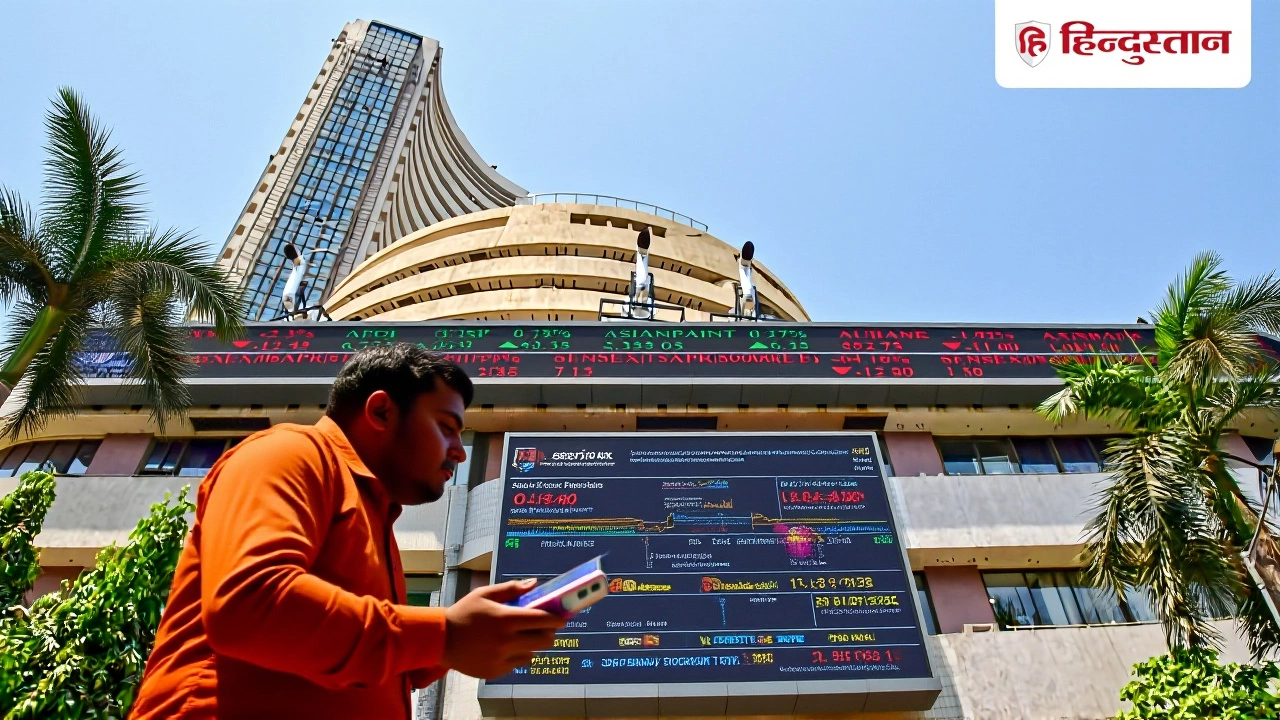When the Sensex slipped 297.07 points to close at 82,029.98 on Tuesday, October 14, 2025, investors felt the chill of a double‑dip. The broader market followed suit, with the Nifty 50 settling at 25,145.5, down 81.85 points. What sparked the sell‑off? A cocktail of U.S. tariff talk, China’s rare‑earth clamp‑down, and a looming futures‑and‑options expiry turned the day into a nervous sprint to the finish.
Market Performance Overview
Tuesday’s close marked the second straight session of losses for India’s benchmarks. On Monday, October 13, the Sensex had already shed 173.77 points, hovering around 82,327, while the Nifty 50 lingered just under the 25,250 mark. The downward drift was not confined to large‑cap indices; the Nifty MidCap 100 fell 0.75 % and the SmallCap 100 slipped 0.89 %. Even the debt market nudged lower, with the five‑year government bond yield trimming about 2 basis points to 5.6350 %.
Sector‑wise, the Nifty PSU Bank index emerged as the top laggard, sliding 1.52 %, trailed by Consumer Durables and Media indices. Pharmaceuticals and metals felt the brunt of the sell‑off, as traders chased safety amid global uncertainty.
Sectoral Pressures and Stock Movers
Among the heavy‑hit stocks, Bajaj Finance, Trent, Tata Steel and Bharat Electronics Limited (BEL) were the day’s biggest drags. In contrast, tech‑heavyweights like Tech Mahindra, financial stalwart ICICI Bank, utility giant Power Grid Corporation of India Limited and consumer giant Hindustan Unilever Limited (HUL) managed modest gains.
Surprisingly, even the market gloom couldn’t dim the debut of LG Electronics India. The South Korean giant listed at a 50 % premium to its issue price, earning the label of the strongest billion‑dollar IPO since the 2021 "Eternal" offering.
Global Cues and Tariff Tensions
The catalyst behind the volatility was a fresh wave of trade rhetoric from Donald Trump, former U.S. President. On Monday, he hinted at escalating tariff threats on Chinese goods, a stance that coincided with Beijing tightening rare‑earth export restrictions. Vinod Nair, Head of Research at Geojit Investments, told The Economic Times that the “dual shock of U.S. tariff chatter and Chinese mineral curbs” was racking up pressure on metal and pharma shares.
“Investors are now pricing in a higher cost‑of‑capital scenario for import‑heavy sectors,” Dr. V.K. Vijayakumar, Chief Investment Strategist at Geojit, observed in a follow‑up commentary. He added that the market’s reaction was amplified by the Nifty futures and options expiry, a period that typically sees heightened hedging activity.
Analyst Views and Recommendations
While the overall tone was bearish, some analysts spotted pockets of opportunity. Somil Mehta, Head – Alternate Research at Mirae Asset Sharekhan, recommended buying Shree Cement in a range of Rs 29,600‑29,700, with a stop‑loss at Rs 29,170 and a target of Rs 30,750. He also flagged Hindalco Industries Limited as a buy between Rs 772‑776, stop‑loss Rs 758, target Rs 810.
On the wealth‑management side, Shivani Nyati, Head of Wealth at Swastika Investmart Ltd., cautioned that “the near‑term risk remains skewed towards downside, especially if tariff negotiations stall.” Yet she noted that “quality blue‑chip names with strong balance sheets could act as anchors during the turbulence.”
Implications for Investors
The twin blows of tariff uncertainty and a capital‑intensive IPO season mean investors will likely stay on the defensive for the next few trading days. The next F&O expiry on Friday could either trigger a short‑cover rally or deepen the slump, depending on how global cues evolve.
For long‑term players, the episode underscores the importance of diversification across sectors less exposed to import‑cost fluctuations—think domestic consumer staples, IT services, and infrastructure. Short‑term traders, on the other hand, might scout for volatility‑play opportunities in metal and pharma stocks, which have already logged double‑digit percentage drops.
Looking Ahead
All eyes now turn to the Washington‑Beijing dialogues slated for early next week. If Trump’s tariff warnings translate into concrete policy, the ripple effects could linger through the quarter. Conversely, a diplomatic thaw might restore confidence, allowing the Sensex to rebound toward the 82,500 level.
Meanwhile, domestic policy makers are watching the bond market closely. The modest dip in five‑year yields hints that investors are still seeking safe‑haven assets, a sign that risk appetite remains fragile.
Frequently Asked Questions
How will the tariff threats affect Indian metal stocks?
If higher U.S. duties on Chinese imports materialize, Indian metal producers could face a two‑fold squeeze: reduced export demand and higher input costs for raw materials sourced from China. Analysts expect a 5‑8 % earnings drag for companies like Tata Steel over the next fiscal year.
What does the Nifty F&O expiry mean for market volatility?
Expiry days often see a surge in contract‑closing activity, prompting traders to unwind positions. This can amplify price swings, especially in mid‑cap and small‑cap stocks that already showed weakness. Expect the VIX to edge higher until the expiry settles.
Why did LG Electronics India’s IPO perform so well?
The company tapped a strong demand for premium consumer electronics in India, positioning itself as a domestic player with global technology. Pricing at a 50 % premium reflected investors’ confidence in its growth trajectory, making it the most successful billion‑dollar IPO since 2021.
What sectors could offer buying opportunities now?
Defensive sectors such as consumer staples, IT services, and infrastructure are likely to provide stability. Additionally, analysts highlighted Shree Cement and Hindalco as potential upside plays, given their reasonable valuations and strong demand fundamentals.
How are bond yields reacting to the equity market dip?
The five‑year government bond yield slipped to 5.6350 %, a modest 2‑basis‑point decline, signaling that investors are seeking safety in debt despite the equity sell‑off. This trend could keep borrowing costs subdued for the near term.
